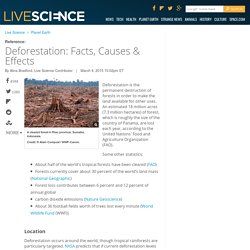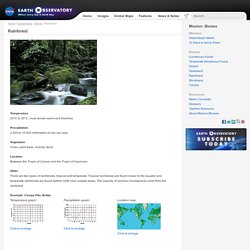

The Rainforest - Green / Earth Issues for Kids: Presented by Children of the Earth United, Green - Environmental Education for Kids, Teachers and Families. Rain Forest Threats, Rain Forest Species. More than half of Earth’s rain forests have already been lost forever to the insatiable human demand for wood and arable land.

Rain forests that once grew over 14 percent of the land on Earth now cover only about 6 percent. And if current deforestation rates continue, these critical habitats could disappear from the planet completely within the next hundred years. The reasons for plundering rain forests are mainly economic. Wealthy nations drive demand for tropical timber, and cash-strapped governments often grant logging concessions at a fraction of the land’s true value. “Homesteader” policies also encourage citizens to clear-cut forests for farms. Threats Solutions. Live Science: Deforestation. Deforestation is the permanent destruction of forests in order to make the land available for other uses.

An estimated 18 million acres (7.3 million hectares) of forest, which is roughly the size of the country of Panama, are lost each year, according to the United Nations' Food and Agriculture Organization (FAO). Some other statistics: About half of the world's tropical forests have been cleared (FAO) Forests currently cover about 30 percent of the world’s land mass (National Geographic) Forest loss contributes between 6 percent and 12 percent of annual global carbon dioxide emissions (Nature Geoscience) About 36 football fields worth of trees lost every minute (World Wildlife Fund (WWF)) Deforestation occurs around the world, though tropical rainforests are particularly targeted.
NASA predicts that if current deforestation levels proceed, the world's rainforests may be completely in as little as 100 years. Error loading player: No playable sources found Weather vs. Rain Forest Threats, Rain Forest Species. Best Way - Amazon Rainforest Survival Guide. Despite the fact the Amazon rainforest is progressively dwindling due to deforestation, it is still vast and people find themselves needing to survive in it on a regular basis.

So it is important to know how to survive in this type of seemingly impenetrable, endless jungle if you are unfortunate enough to find yourself stranded there for an extended period of time. While access to food and water are the first concerns, keeping yourself safe from wild animals and knowing what not to consume is also important. Water Considerations While it is a rainforest, which by definition means it rains regularly, it is still rather difficult to obtain water which is not contaminated and is safe for you to drink.
Drinking bad water can make you very sick and lead to parasites growing in your stomach which can sometimes kill you, among other unpleasant things. Edible Plants There are many plants or fruits from these plants which can be eaten. Rainforest facts, photos and how to prevent their destruction. The Living Rainforest. Rainforest. Rainforests are forests characterized by high rainfall, with annual rainfall between 250 and 450 centimetres (98 and 177 in).[1] There are two types of rainforest: tropical rainforest and temperate rainforest.

The monsoon trough, alternatively known as the intertropical convergence zone, plays a significant role in creating the climatic conditions necessary for the Earth's tropical rainforests. Tropical Tropical rainforests are characterized by a warm and wet climate. Mean monthly temperatures exceed 18 °C (64 °F) during all months of the year.[5] Average annual rainfall is no less than 168 cm (66 in) and can exceed 1,000 cm (390 in) although it typically lies between 175 cm (69 in) and 200 cm (79 in).[6] Many of the world's rainforests are associated with the location of the monsoon trough, also known as the intertropical convergence zone.[7] Tropical rainforests are located in the tropics, i.e., in the equatorial zone between the Tropic of Cancer and Tropic of Capricorn. Temperate Layers. KS3 Geography - Tropical rainforest biomes - Revision 1. Tropical Rainforest. Where are tropical rainforests found?

Tropical rainforests are located around the equator where temperatures stay near 80 degrees year round. Rainforests receive 160 to 400 inches (400-1000 cm) of rain each year. What is a Rainforest? NASA: Earth Observatory. Temperature 20°C to 25°C, must remain warm and frost-free Precipitation 2,000 to 10,000 millimeters of rain per year Vegetation Vines, palm trees, orchids, ferns Location.

Rainforest Concern Facts. For a downloadable booklet of rainforest facts and other materials for use in the classroom, please go to Resources for Schools Tropical rainforests - where and what are they?

Tropical rainforests are found across the world between the Tropic of Capricorn and the Tropic of Cancer, 22.5° North and 22.5° South of the Equator. Rainforest Interactive Tour. Layers of the Rainforest. Rainforest Animals. National Geographic. Rainforest Information. How Rainforests Work" Layers of a Rainforest.